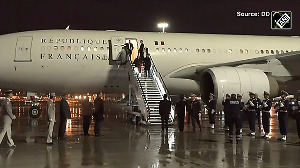Launching satellites is always considered risky business by those who do it as well as those who insure it.
This year, things might just get tougher for those who want to put their spacecraft up there, especially if those satellites are the kind that drive much larger downstream businesses.
One of the reasons is that last year four in-orbit satellites failed, all of them insured. A fifth one was not. That meant global insurance companies who were otherwise profitable, had to deal with those claims, says the Willis Group, which among other things offers insurance cover to companies and/or organisations putting satellites in space.
Premiums in this business can be as high as 25 per cent of the cost of a given mission, says a top official from the Indian Space Research Organisation, which insures its INSAT series of communications satellites.
"In India, New India Assurance is one company that does this... but they also re-insure so it is all about spreading the risk," the official said.
Willis Inspace, a division of the Willis Group, provides insurance and risk management services to the space industry. In a bulletin, two weeks ago, Inspace said total premium income for the sector was originally estimated at between $900 million and $950 million.
But a number of launches planned for the fourth quarter slipping into 2005 meant that premium associated with those launches will only be earned this year. Actual earned premium in the sector is now estimated at between $675 million and $725 million, Inspace said.
"From a claims perspective," Inspace said, "successful launches during 2004 were tempered by continued incidence of in-orbit failures."
In 2004, anomalies were reported in five in-orbit satellites -- Amazonas 1, Estrela do Sul, Galaxy 10R, Superbird 6 and Intelsat Americas 7 (which was uninsured).
While the claims quantum for the four insured satellites is still to be determined, "the likelihood is that these claims will eradicate a significant proportion of the concerned insurers' premium for 2004."
Further, all annual in-orbit policies written in 2004 will maintain exposure in 2005 and it will not be untill the last of these policies has expired (in December 2005), that an accurate premium/claims analysis for 2004 can be made, Inspace said.
Market capacity, or the ability to insure, within the sector didn't change in 2004 with no new entrants and no official retractions of capacity.
Insurers are currently finalising their re-insurance provisions for 2005, but the capacity was $365 million for launches and $220 million for in-orbit risks.
The failures in the latter segment has made insurers selective about which risks they would provide cover for, Inspace said.
"So it is possible those seeking any new cover will have to pay through their noses," the ISRO official remarked.
From the insurers point of view, 2004 was for the third consecutive year a success for launch vehicles cover providers, as launch success rate averaged 97 per cent over that period.
This year would be part of a period of consolidation and stability that resulted from a contraction in market capacity starting 1998, Inspace said.
Premium rates in 2005 would be significantly higher than they were during more volatile times five years ago. Insurers were also resisting reductions in premium rates, Inspace said.






 © 2025
© 2025